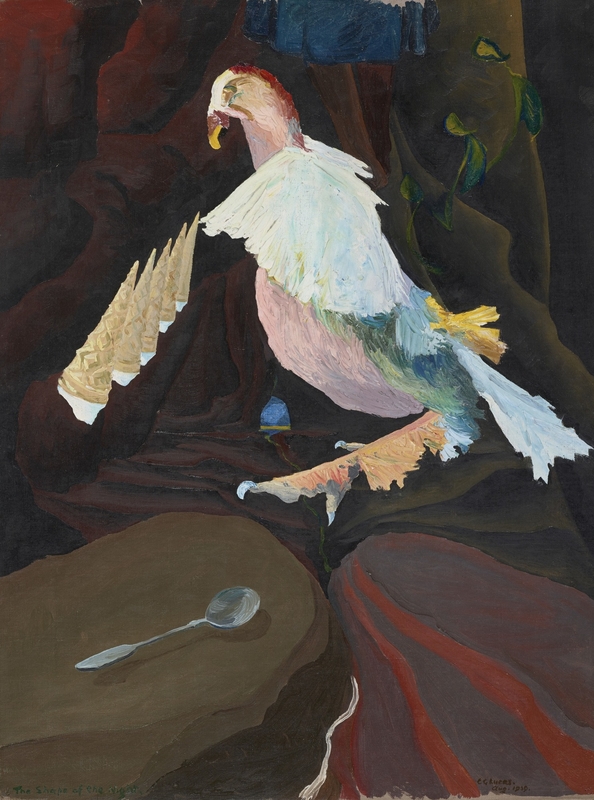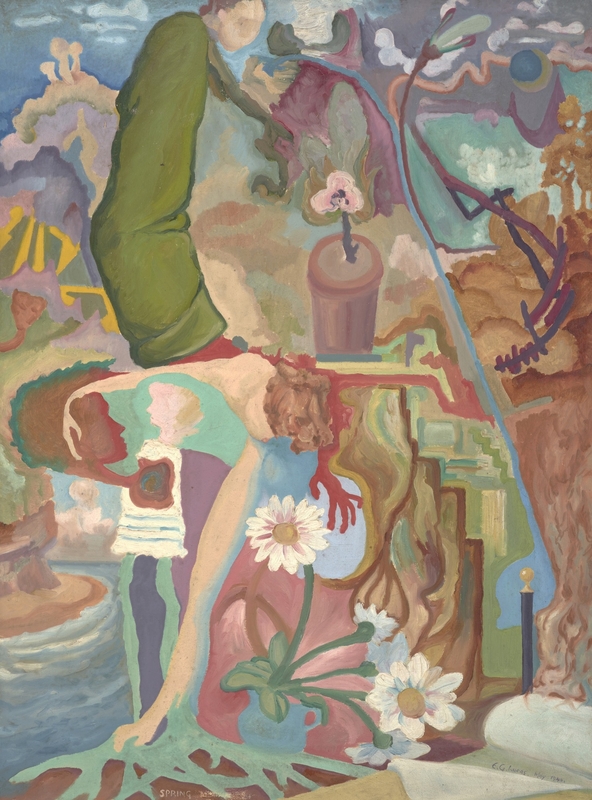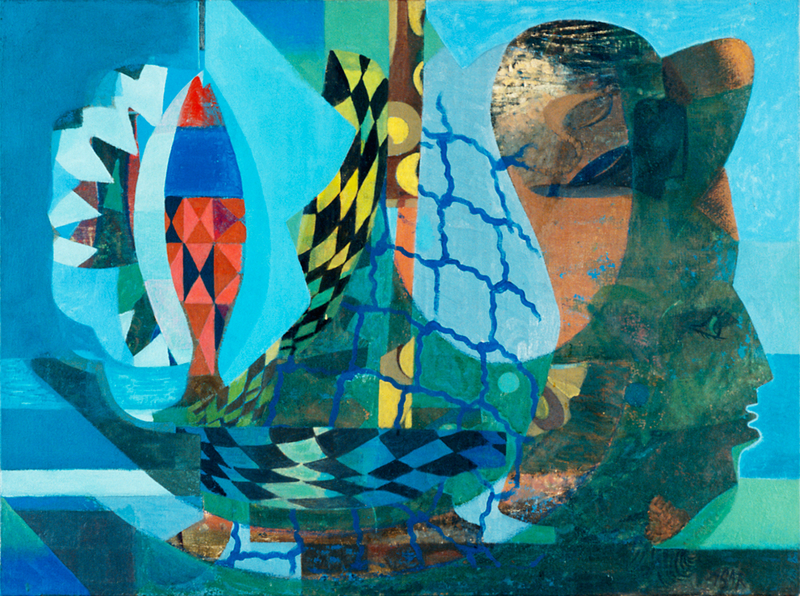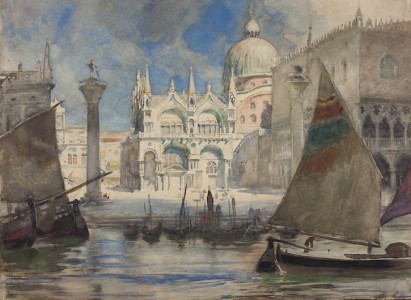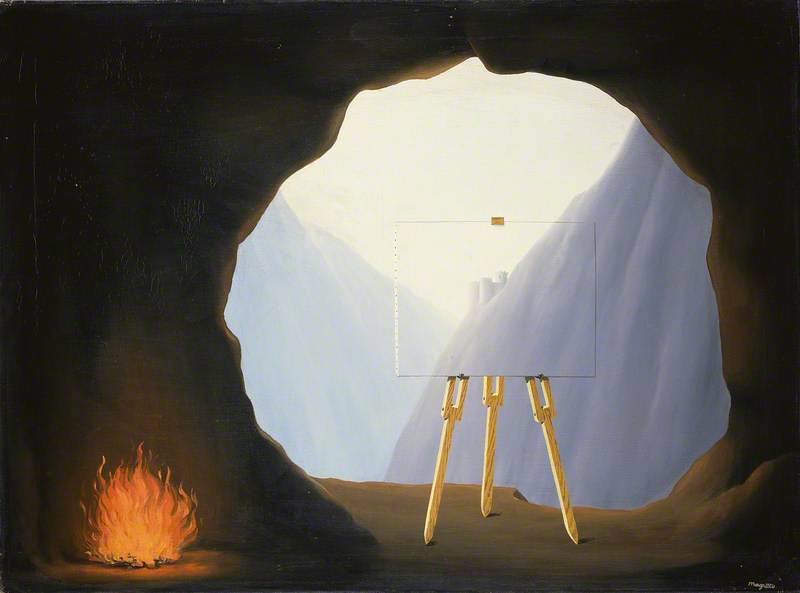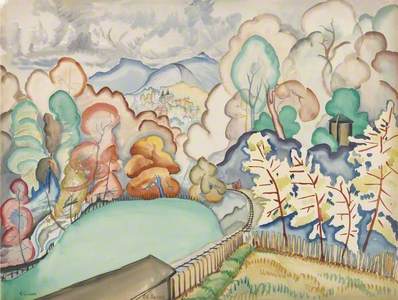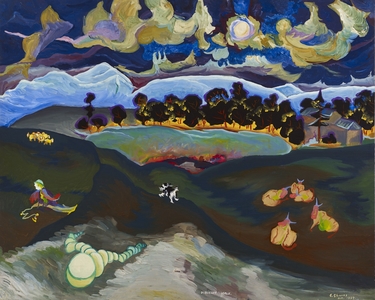Edwin George Lucas, my father, was a Scottish artist who took inspiration from Surrealism in the late 1930s and went on to create a body of work that's unique in twentieth-century British art.
He was little known during his lifetime, but his profile has grown during the last ten years, particularly in Scotland. His work went to England for the first time in 2023, with a retrospective at Beecroft Art Gallery in Southend-on-Sea. He described himself as a 'purely Individual painter', and I hope this story illustrates why.
During the early 1930s, he worked mainly in watercolours, often local landscapes painted outdoors.
Snuff Mill, Juniper Green
1936, watercolour on paper by Edwin George Lucas (1911–1990) 
In the mid-1930s he made several friends who were students at Edinburgh College of Art, including Wilhelmina Barns-Graham, who later became part of the group of modernist artists at St Ives. This contact with other artists may have encouraged him to take his own art more seriously. Otherwise self-taught, he attended life drawing evening classes, and joined the Society of Scottish Artists (SSA).
Photograph of Wilhelmina Barns-Graham sketching Edwin G. Lucas, c.1936–1937
He also started experimenting with oil paints, although still mainly using watercolours, and his style became more adventurous.
Water of Leith Valley and Pentland Hills from Kingsknowe
1938
Edwin George Lucas (1911–1990) 
Lucas started subletting Barns-Graham's studio in August 1939, after she left Edinburgh. For the first time he had a space dedicated to painting, and his artistic practice changed dramatically. He now focused mainly on oil painting, and Surrealism became evident in much of his work.
The Shape of the Night is his second Surrealist painting, created during his first month in the studio. It's tempting to think there's a connection with René Magritte's work, but Lucas has made this his own.
Moonlit Walk was painted in October 1939, just a couple of months after Lucas started painting in a Surrealist style. Much of his work in this period was related to dreams and/or psychoanalysis, and this may be a dreamscape. It's unique in the way he combines local landscape (the Pentland Hills) with surreal imagery such as the shepherd with wonky legs, his dog and the ghostly cows. Not to mention the strange, green, worm-like object in the foreground.
Spring, dated May 1940, features figures and plant forms. I assume the bed at bottom right is a strong hint that it's a dreamscape.
The Schism – Final Diagnosis
1940
Edwin George Lucas (1911–1990) 
The title of The Schism – Final Diagnosis, and the figure reclining in the foreground, possibly on an analyst's couch, suggest a connection with psychoanalysis. The Surrealists were fascinated by Sigmund Freud's work, and I remember my father discussing Freud several times.
Unfortunately, I never discussed this painting with him, but there's evidence to suggest he may have regarded it as the end of what he later referred to as his 'brief flirtation with Surrealism':
Firstly, his very first Surrealist work, painted in August 1939, was titled Diagnosis 1, and this is Final Diagnosis. Additionally, it's almost certainly the work he exhibited in 1951 entitled A Farewell to Surrealism, dated 1940. Finally, perhaps The Schism in the title refers to a parting of the ways.
Proem
1940, ink on paper by Edwin George Lucas (1911–1990) 
An important part of Lucas's output during his 'flirtation with Surrealism' was a series of uncanny drawings. Here we see Proem, dated 5th August 1940. Recent research by Edward Cockburn-Price has identified the subject as Dante Alighieri's 1320 work, The Divine Comedy.
This interpretation identifies the figure bottom left as Virgil, the three animals, in ascending order, as the leopard, lion and she-wolf of Dante's epic, and the path through the valley on the right as the 'straight way' to salvation (symbolised by the sun behind the mountain).
Cockburn-Price goes on to propose a detailed psychological interpretation of Proem, based on tension between Lucas's day job in the civil service and his perception of himself as an artist first and foremost.
Lucas was committed to pacifism throughout his life and was a conscientious objector during the Second World War. He worked in various hospitals throughout Scotland and spent his free time painting watercolour landscapes.
Near Killearn
1943, watercolour on paper by Edwin George Lucas (1911–1990) 
He was posted to Killearn Hospital in 1943, then Raigmore Hospital near Inverness, then to the Royal Edinburgh Hospital in mid-1944. The latter allowed him to resume studio life in the same studio as before. At the end of the war, he went back to work as a civil servant.
The post-war years were his most creative and prolific. He had a day job to provide funds but saw himself primarily as a serious painter. He was free to paint whatever he liked, rather than being constrained by the rather conservative Scottish art market.
For him, in his own words, 'the purpose of art was the enlargement of experience and, in painting, that meant continual innovation and the refusal to create a personal style by self repetition'. He experimented with many different styles and subjects, leading to work that's very varied and quite unlike what others were doing.
Earlier in his career, Edwin regularly exhibited at the open exhibitions held by the SSA and sometimes the Royal Scottish Academy, but by the mid-1940s they were accepting only his landscape works. He complained later that 'these bodies consistently rejected anything that he regarded as original work'. He resigned his SSA membership in 1948, probably in frustration.
Walking the Dog came later, in 1949, and was inspired by a family day out. The figure on the left with the big blue eye is the artist himself, and the figure on the right is his father. In the middle is probably Lucas's mother, the three dots being buttons on her blouse. Of course, you can also spot the dog.
Pentland Hills from Kingsknowe, Winter
1947
Edwin George Lucas (1911–1990) 
Avant-garde works were the main focus of Lucas's mature career, but he continued to paint local landscapes too. These were almost always highly coloured, but otherwise each one was unique. Even when he painted the same scene several times, as he did with the view shown above and below, he varied the style dramatically.
Winter Landscape, Kingsknowe
1948, oil on canvas by Edwin George Lucas (1911–1990) 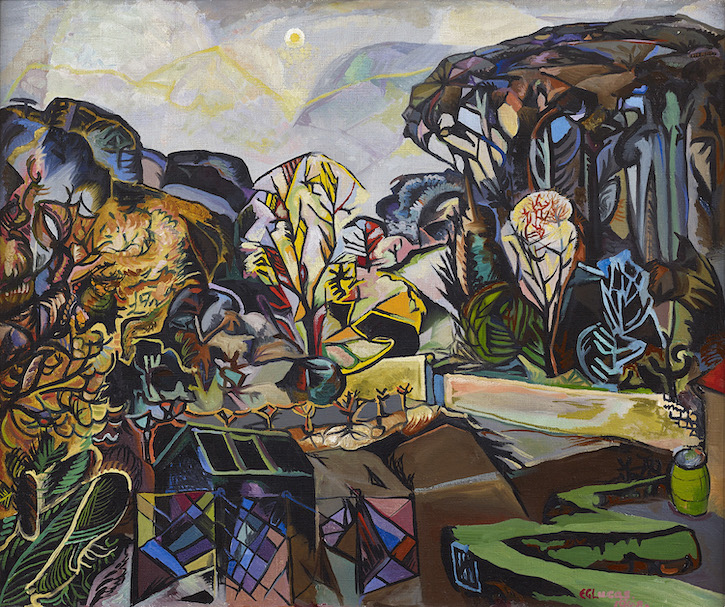
In 1950, he organised a solo exhibition in Edinburgh. He exhibited 73 oil paintings and 21 watercolours, produced between 1936 and 1950. The Evening Dispatch printed photographs of the exhibition and The Scotsman printed a review. The latter praised his excellent draughtsmanship but said much of the work was 'individual in the wrong way.'
The following year he held another exhibition, of new paintings. There were 58 works, all oil paintings, 23 of them newly painted, others painted earlier but not exhibited before, and a few exhibited the previous year. It coincided with the Edinburgh Festival and received little attention, probably rendered invisible by all the other festival events.
Taboo (Peep!)
1951, oil on board by Edwin George Lucas (1911–1990) 
Edwin married in 1952. He later said that he had no intention of giving up painting but found it to be unviable in the atmosphere of domestic and family responsibilities. He put away his brushes and didn't pick them up again for nearly 30 years, after my brother and I had left home.
Reflection – Self Portrait (Evening)
1986, oil on board by Edwin George Lucas (1911–1990) 
He painted several fascinating works in the 1980s, some with connections to previous works, but his approach remained as versatile and individual as before. He hoped to achieve more recognition but was thwarted by failing eyesight.
The last act of his artistic career was to gift his 1942 painting Caley Station, Edinburgh to Edinburgh's City Art Centre. He drafted some notes to accompany the work. They finished with the words: 'He thought of himself as a purely individual painter'.
Caley Station, Edinburgh, 1942
Edwin George Lucas (1911–1990) 
Lucas remained almost completely unknown until 2013 when the Scottish National Gallery of Modern Art acquired and exhibited five of his paintings. Many daily newspapers published stories about the discovery of a previously unknown Scottish Surrealist.
Subsequently his work has been displayed at the National Galleries of Scotland on several occasions, alongside masterpieces by the stars of international Surrealism.
A major retrospective, 'Edwin G. Lucas: An Individual Eye', was held at the City Art Centre from Aug 2018 to Feb 2019. This exhibition then visited England for the first time, at the Beecroft Art Gallery in Southend-on-Sea from June to September 2023.
Alan Lucas, representative of the estate of Edwin G. Lucas
Further reading
Edward Cockburn-Price, A True Portrait of Edwin G. Lucas: Personal Subconscious Themes in his Inner Landscapes, unpublished MPhil essay, University of Cambridge, 2024
Alan Lucas, The Surrealist Drawings of Edwin G. Lucas, Estate of Edwin G. Lucas, 2018
Helen E. Scott, Edwin G. Lucas: An Individual Eye, Sansom & Company, 2018 – available to purchase in the Art UK Shop
